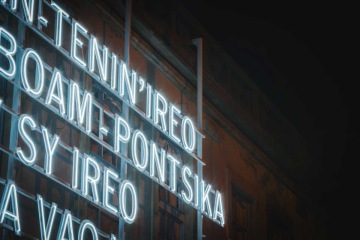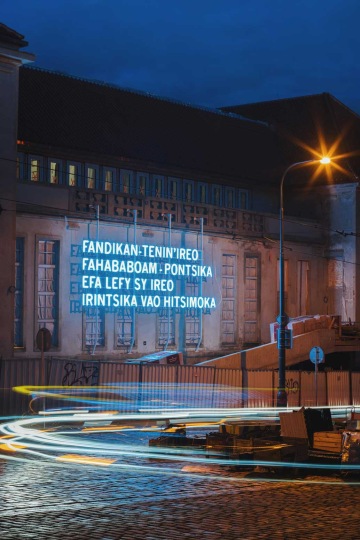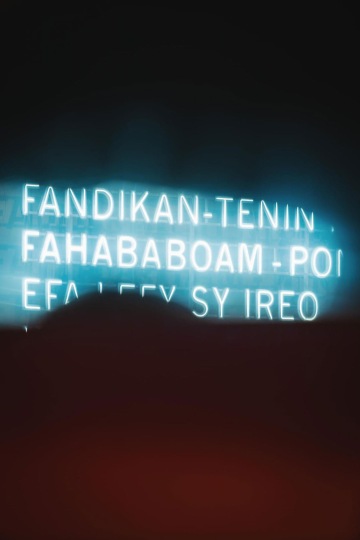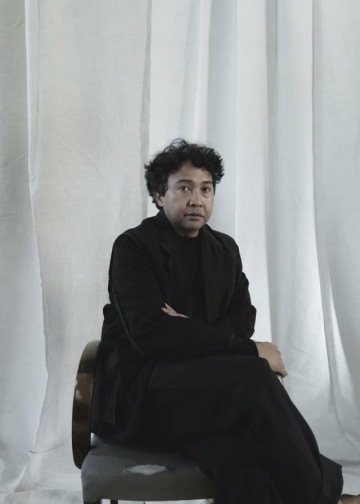Facade Project: Joël Andrianomearisoa
TRANSLATIONS OF ALL
OUR LOST PASSIONS
AND OUR FUTURE DESIRES
Invited to create an installation for the 5th edition of the Facade Project, Joël Andrianomearisoa chose to extend his intervention beyond the walls of the Kunsthalle, into spaces inaccessible to the public. Although it has been revealed on our digital platforms, the building’s interior is still under construction. It is precisely this phase of transformation, this passage of the site from one state to another, this spatial and temporal ‘in-between’, that inspires the artist.
For Joël Andrianomearisoa, developing a new project means immersing himself in an environment. A ‘total’ artist, he is sensitive to the essence of a space. It is only after gaining a physical awareness of a city, its architecture, its energy, that he can begin to elaborate a story. When he first came to Prague to visit the Kunsthalle site, Joël Andrianomearisoa found the city as it had not been since the Velvet Revolution. Deprived of tourists, it was as if frozen. This was in June, a few weeks after the first lockdown restrictions were lifted. Planning an international exhibition in such a context seemed a risky endeavour. Ordinarily simple questions, such as the transportation of the art pieces, or the artist’s participation in the installation, became complex problems. Which methods, and which strategies, would make it possible to work around possible new restrictions?
Conscious of these unprecedented times and the urgency of the moment, Joël Andrianomearisoa questions the practice of Mail art. Published in 1982, during the Cold War, the International Mail Art Manifesto* proclaimed that ‘Mail Art spreads out through the international mail (its medium) which is employed as resonance box, with its crises, troubles and precariousness’. This movement, which grew out of Neo-Dada and Fluxus, brought together thousands of correspondents around the world. For some, the appeal of mail art laid in its experimental dimension. For others, living under dictatorships, it represented the only means of communicating and interacting with foreign countries. This was the case for artists from Eastern Europe and Latin America.
In the spirit of the Mail Art movement, Joël Andrianomearisoa strives to establish a new type of exchange between his works and the public, between his convictions and the reality of the world. To engage with the transforming spaces of the Kunsthalle Praha, the artist has conceived an epistolary project, which he calls ‘Translations of all our lost passions and our future desires’.
Joël Andrianomearisoa has decided to display this title in glowing neon letters on the building’s façade, and to write this text in his mother tongue: Malagasy. The decision not to translate a rare language, in a location where it has little chance of being understood, is deliberate. Not to translate is to avoid the ‘approximation of discourse which produces a new discourse’. **
The enigmatic sentence invites us to consider otherness. Language and multilingualism have always lain at the heart of Joël Andrianomearisoa's approach. As a multicultural artist, he manipulates words much as he does objects; assembling, combining and interpreting textures and texts from here and elsewhere, creating a protean, polyphonic work.
‘Translations of all our lost passions and our future desires’ unfolds over time. ‘Translations’ here also carries the meaning of ‘transmissions’. Several times a month, from February to June, Joël Andrianomearisoa will mail us ‘letter-works’ created with an economy of means from the everyday objects and materials of our time. Establishing an ongoing correspondence between Paris, Antananarivo – his two cities of residence – and Prague, he offers us a chronicle of his work. As they are received at the Kunsthalle, each of the objects – drawings, assemblages, images, works, textiles, foldings, sound-based pieces – will be distributed throughout these spaces-in-the-making. Makeshift exhibitions, or those without anyone to attend them – such presentational techniques are no longer surprising, having become the norm over the past year. What sets Joël Andrianomearisoa's project apart is its temporal aspect. It is an exhibition as work-in-progress, viewed over a period of time and consisting of narrative sequences appearing at regular intervals on social media. The gradual unveiling of the works and the resulting sense of expectation act as vectors for desires, promises, and hopes.
*Romano Peli a Michaela Versari: Manifesto Internazionale dell’Arte Postale, in: „Poste Arte“, Itálie 1982.
**Kenneth Goldsmith: Against Translation, Jean Boite Éditions, 2016
Curator: Christelle Havranek
Project manager: Kateřina Slavíková
JOËL ANDRIANOMEARISOA (*1977)
Joël Andrianomearisoa (*1977) lives and works between Paris and Antananarivo, the capital of Madagascar. He switches between roles as a visual artist, scenographer, poet. As a “total artist” he is sensitive to the essence of space. It is only after gaining a physical awareness of a city, its architecture, its energy, that he can begin to elaborate a story. Within the given spaces and times, he then imagines sequences and itineraries and fills them with artworks, movements, texts, and, most importantly, emotions. As a multicultural artist he assembles, combines and interprets textures and texts from here and elsewhere, creating a protean, polyphonic work.
In 2019 Andrianomearisoa was the first artist to represent his native Madagascar at the 58th Venice Biennale. In 2020 he participated in the 22nd Sydney Biennale. Four years earlier he received the Arco Audemars Piguet Prize in Madrid. He has worked with the influential fashion brand Dior, among other things.
His multi-layered works are represented in numerous public and private collections, including the National Museum of African Art in Washington DC; Zeitz MOCAA, Cape Town, South Africa; the Studio Museum in Harlem in New York; and the Collection Revue Noire in Paris, France.
Photo © Lukáš Masner




